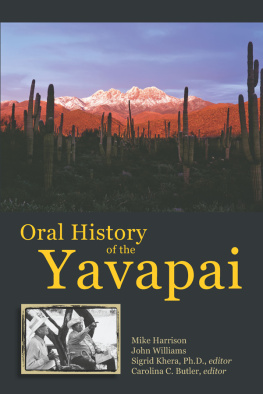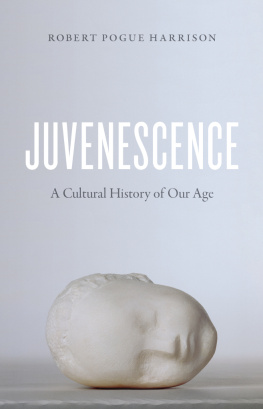ORAL HISTORY OF THE YAVAPAI
This book belongs in every American History classroom.
Ernest Jones, Sr., President
Yavapai-Prescott Indian Tribe and Tribal Board of Directors
Not enough is taught in our schools about what happened to the American Indians. We are glad this book has brought our side of history to the public. As the State of Arizona celebrates its one hundred birthday in February 2012, my hope is this book sheds new light on the subject with greater understanding for all peoples, including the original inhabitants of Arizona.
Raphael Bear, President 2004-2008
Fort McDowell Yavapai Nation
I am pleased to join the praise of this fine book, Oral History of the Yavapai by Yavapai elders Mike Harrison and John Williams and by Sigrid Khera, anthropologist, and Carolina Butler. This historical work will benefit not only the Yavapai and other Native Americans but all Arizonans and far beyond even our borders.
Dennis DeConcini
United States Senator from Arizona 1987-1995, Retired
Using insightful accounts, this engaging oral history provides a timely understanding of the Yavapai, their history and culture for Arizonas Centennial.
Donald Fixico, Ph.D.
Distinguished Foundation Professor of History & Affiliate Faculty of American Indian Studies Arizona State University
I was delighted to see this long-awaited project reach completion. This volume is a significant addition to Yavapai history and a lasting contribution to the full story of the Southwest.
Peter Iverson, Ph.D.
Regents Professor of History
Arizona State University and author of Carlos Montezuma and the Changing World of American Indians
This book is a valuable resource for not only the Yavapai people but for anyone who wants to know and understand American Indians. It provides an accurate recounting of Yavapai history and a detailed portrayal of the Yavapai culture and way of life through the eyewitness words of two men whose lives and memories encompass the transition from the old ways to modern times after the clashing interaction with white people.
Leon Speroff, M.D.
and author of Carlos Montezuma, M.D.
This book deals with the history, stories, traditions and life-ways of the Yavapai as narrated by two respected Yavapai elders, carefully recorded and lovingly preserved by their friends, Sigrid Khera and Carolina Butler. Mike Harrison and John Williams wanted people to know that the Yavapai are a separate people, distinct from the Apache, with whom they have historically been confused.
It is a rare book in that it recounts the history of Yavapai-Euroamerican relationships during the 1800s from the Yavapai perspective, as told to Mike and John by their parents generation.
This makes Oral History of the Yavapai an important volume for anthropologists, historians, and the Yavapai people themselves, since that generation was the last to have lived a traditional lifestyle before Yavapai culture was decimated by war and forced incarceration outside their homeland.
It will provide readers with an account of the Apache war period and the Long Walk to San Carlos that is not found elsewhere. It is also a first-person narrative about a Yavapai mans life in the 20th century. Oral History of the Yavapai is a significant addition to the meager literature that is available about the Yavapai, their culture, and history. It should become mandatory reading for anyone interested in the Yavapai, the Apache, and the Indian Wars period in Arizona.
Peter J. Pilles, Jr.
Forest Archaeologist
Coconino National Forest
Carlos Montezuma of the Yavapai tribe was the fascinating focus of my research. In the course of that work, I was lucky to have met some special Fort McDowell Yavapai. Late afternoons by the lovely Verde River, we would sit, talk, be silent together, talk some more. Not only about their fascinating history but about their beliefs, the Spirits of Four Peaks, creation, and a wonderfully mischievious trickster spirit whose clever and well-timed pranks kept folks on the proper path.
In that meaningfully rich context, it is a joy to commend this work. Reading history in the Native folks own words, sensing their feelings, and probing their hearts and minds seldom occurs. This book is a welcome event not just for Native America, but for all peoples everywhere.
John W. Larner, Ph.D.
Editor, The Papers of Carlos Montezuma, M.D.
As an historical consultant to the Government of Canada, I work closely with the primary documents associated with aboriginal peoples on both sides of the Canada/United States international boundary. Consequently, I am intimately acquainted with the significance of having access to the Oral History of the Yavapai and with the importance of those historical records even existing.
Pamela Y. Stanton, Ph.D.
Mayne Island, BC, Canada
[Editors note: Ernest Jones, Sr., Prescott Yavapai, is a great-grandson of the great Yavapai medicine man Jim Mukhat. Raphael Bear, Fort McDowell Yavapai, is a grandson of famed basketweaver Bessie Mike.]
The University of Arizona Press
www.uapress.arizona.edu
2012 by Carolina C. Butler
All rights reserved
First published 2012 by Acacia Publishing, Inc., Gilbert, Arizona
ISBN-13: 978-0-8165-3254-4 (paper)
Cover design: Carla Olson, www.bluefrogjump.com
Cover photos: Wigidjassa (Four Peaks) 7,657 elev., by Elias Butler, www.eliasbutler.com; John Williams and Mike Harrison photo by Melissa Jones
Library of Congress Control Number:
2012941000
Printed in the United States of America
 This paper meets the requirements of ANSI/NISO Z39.48-1992 (Permanence of Paper).
This paper meets the requirements of ANSI/NISO Z39.48-1992 (Permanence of Paper).
ISBN-13: 978-0-8165-4919-1 (electronic)
Dedicated to the bravery of the Yavapai
The basket shown on each of the five Part I-V section pages was woven in 1974 at the Fort McDowell Reservation by Yavapai basketweaver Emma Johnson (1904-1976). Basket is in the collection of Carolina Butler.
In 1955, Karl Heider, a Harvard anthropology student, interviewed Yavapai elders Nellie Quail and Warren Gazzam at Fort McDowell about Yavapai pottery.
Karl Heider: Were there any decorations?
Nellie Quail: May be some times. Arrow point. The diamond shape is our tribes.
Warren Gazzam: Some designs go way back to the cliff dwellers.
Nellie: But thats oursthe diamond shape. They could use just the point or the whole of it. But its the same.
Thus, we have used the diamond shape, which has also been used extensively in Yavapai basketweaving, to decorate the title page, the contents page and each of the chapter title pages.

Emma Johnson, Fort McDowell Yavapai, September 1975. Photo by Sigrid Khera.
CAUTION
Make safety your top concern when enjoying Arizonas outdoors. Take water, food, cell phone, and extra water in your car. Wear protective shoes, hat, clothing, etc. Tell someone where you are going and when to expect you back.
Inform yourself at Arizonas Office of Tourism or at a Visitor Center or park ranger station for safety tips for the place you are visiting. Call 911 for emergencies.
Inform yourself on the laws protecting Arizonas plants and animals. Vandalism can be reported to park rangers or law enforcement. Help protect and preserve the environment.
Neither the editor nor publisher endorse the consumption or any use of Arizonas wild plants mentioned in this book. Do not touch cactus needles or poison ivy.















 This paper meets the requirements of ANSI/NISO Z39.48-1992 (Permanence of Paper).
This paper meets the requirements of ANSI/NISO Z39.48-1992 (Permanence of Paper).